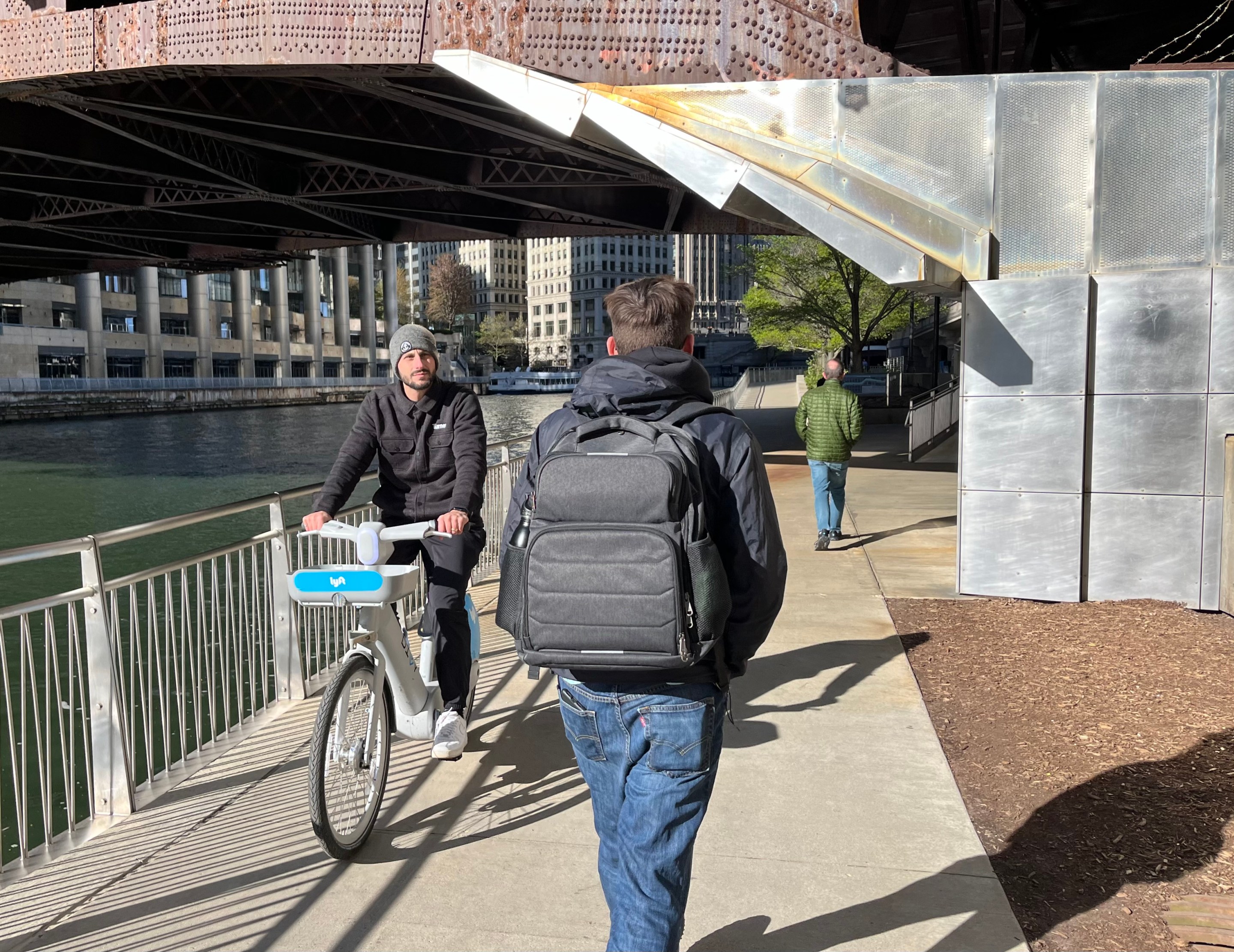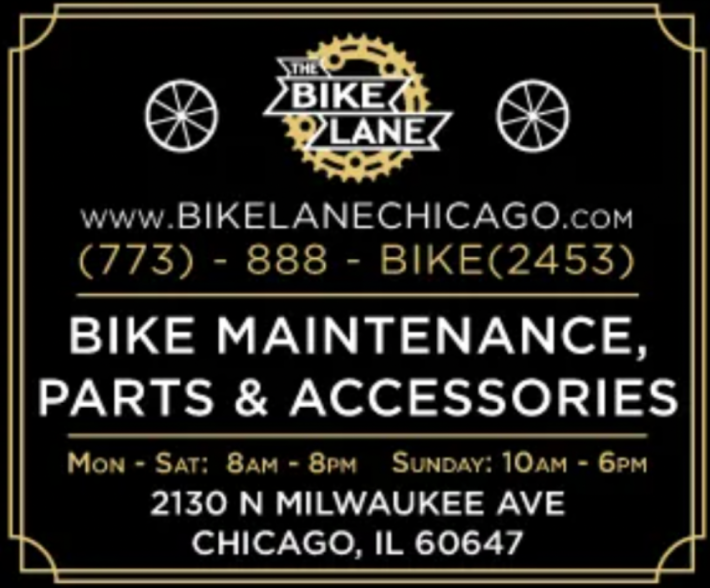
Update 4/26/24, 12:30 PM: I hear you! After this post was shared on social media, at least 75 percent of respondents had the attitude I predicted below, essentially saying "Whether the riverwalk bike ban is fair or not, I don't care because I don't want to ride there anyway." Many argued that advocates should instead focus on getting the proposed Wacker Drive protected lanes built. Streetsblog photo contributor Eric Allix Rogers stated that POV eloquently.
Do I want to bike on the Riverwalk? No. Is it reasonable to be angry that the City pulled a bait-and-switch, selling it & securing funding for it as a bike route that it was never intended to be? Yes. Build the damn Upper Wacker cycle track already! https://t.co/bwDusbDD5o
— Eric Allix Rogers (@EricAllixRogers) April 26, 2024
So, point taken, I will avoid writing much more about riverwalk cycling policy unless I hear back from the Chicago Department of Transportation and/or Fleet and Facility Management on this matter, or there's some other breaking news. Instead, I'll shift my attention on efforts to build the proposed Wacker PBLs. Look for more coverage of that topic next week.
– John Greenfield, editor-in-chief
I know what some of you are thinking after reading this headline. "Geez Louise, is Greenfield going to harp on about the right to ride bicycles on the Chicago Riverwalk again? Didn't he declare 'victory' on this issue years ago? And even if the City is banning cycling on the corridor again, it's not the greatest place in the world to ride a bike anyway. You need to make lots of sharp turns to get around most of the bridge houses, and some sections get so crowded it truly is unsafe to ride through them at anything more than walking speed. Is this really a hill worth dying on?"
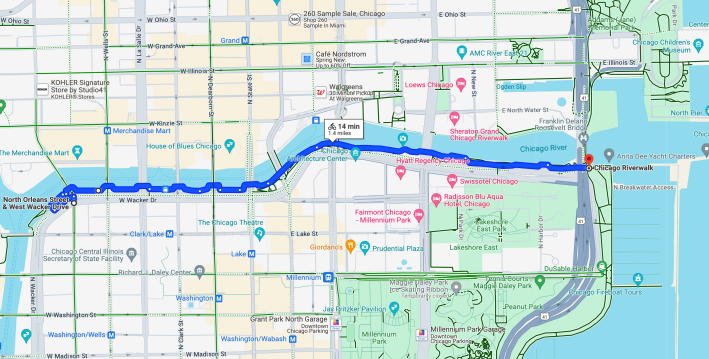
Let me respond to these talking points before moving forward. Yes, by October 2019 I thought that, after security guards started enforcing a de-facto bike ban earlier that year, bike advocates had won the war on this issue. By then a spokesperson for the Chicago Department of Transportation, which built the riverwalk, had acknowledged that biking there was legal "when the Riverwalk is not congested."
And Michelle Woods, an assistant project manager with the Chicago Department of Fleet and Facility Management (2FM), which manages the riverwalk, indicated that a proposed ordinance to officially ban biking there was off the table. "The City is committed to keeping the Chicago Riverwalk safe and regulated for all [emphasis added] residents and visitors to enjoy," she said via email. "Currently, [CDOT and 2FM] are working closely with the Active Transportation Alliance to develop and implement riverwalk rules and regulations pertaining to bicycles, scooters and other mobility devices. These regulations are aimed at keeping all people using the riverwalk safe and, if approved, will inform new signage planned for 2020."
However, it's worth noting that the signs along the corridor at the time stating, "Bicycles must be walked. Violators will be prosecuted" were never replaced. More on why that's a problem in a bit.

Here I should mention that downtown alderperson Brendan Reilly (42nd) was the City Council member who introduced the bike ban ordinance. It was never even voted on in committee, let alone put before the full Council. In fairness, I'm sure the alder got feedback from various constituents on this subject, including the ward's many seniors, some of whom may have been worried about being struck while walking on the riverfront. And, as I recently acknowledged in an interview with Ald. Reilly, I may have previously trolled him a little harder than necessary on the bike ban issue, so I'll try to keep all further discussion of this topic civil.
Now, it's true that the riverwalk generally isn't in the same class as the Lakefront Trail and many other Chicago mixed-use paths. It's certainly not an appropriate place for high-speed biking. Even slow-to-moderate riding requires watching out for and yielding to pedestrians, and taking it easy around the bridge houses.
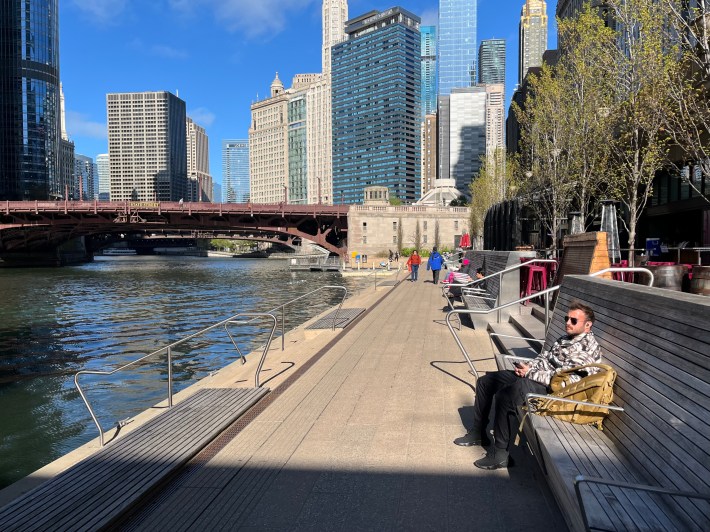
And some times and places really aren't appropriate for cycling on the riverwalk. For example, early evenings and weekends by the outdoor cafe area between State and Clark Streets can get very congested. In those situations you do need to walk your bike, or else stay in the saddle and push your cycle with one foot at something like 3 mph.
But obviously, the riverwalk is an incredibly scenic place to ride a bike. And, especially during the morning rush hours, when there's relatively low pedestrian traffic on the corridor, it's a handy car-free bike route between the Lakefront Trail and the central Loop.
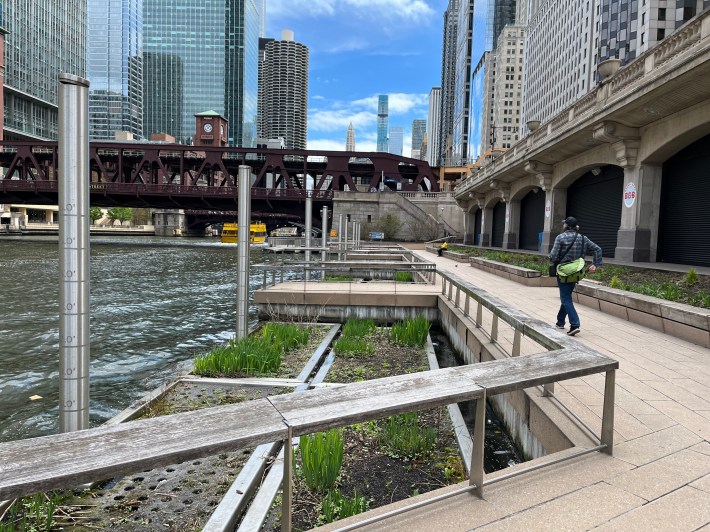
So, I was shocked when I took Streetsblog San Francisco editor Roger Rudick on a bike tour of the Loop last week and learned that the de-facto riverfront bike ban had not gone the way of the dinosaur. As we rode along the corridor, two different security guards flagged us down, and politely insisted it was illegal to ride there. It was around 11:30 a.m. on Wednesday, there weren't many people using the path, and the eating and drinking establishments were't even open for the season. It felt like 2019 all over again.
"A lot of people say when you go on the Internet it says it's a bike path," acknowledged the first guard. She stopped us a couple blocks after we rolled down the ramp just west of Franklin to access the riverwalk. "But it's a new rule... We're not out here to be [a jerk], or mess with y'all. We just do what we are told. The only thing I can do is to ask you, I can't tell you, to walk your wheels. But it's up to you if you want to listen."
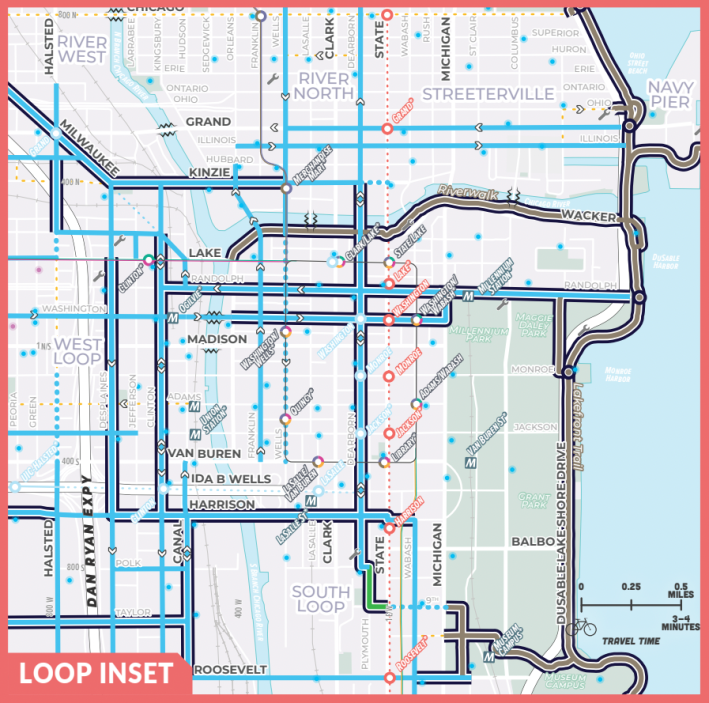
We decided to take the high road and walk our bikes on the riverwalk while we were within her sight. But a couple blocks later we resumed pedaling to save time. However, just west of Michigan, another guard signaled for us to stop. "You've got to dismount off your bikes," he said. "It's the riverWALK, Sir. The City wants no bike riding on this pathway, OK?" So we walked the remaining half mile to the lake.
But in reality, the City's proposal for a $98.66 million federal loan for the project said that the facility would include "bicycle and pedestrian facilities" with "bicycle paths and pedestrian trails along the continuous promenade." And there were at least six other instances where officials promised that the riverwalk would accommodate bike riding.
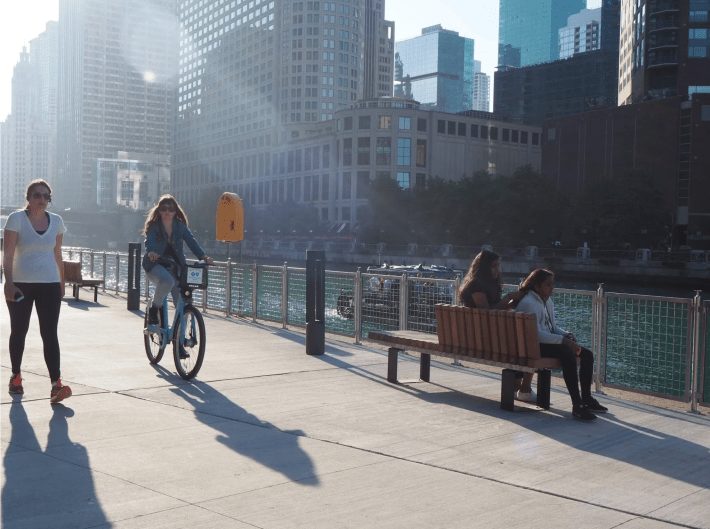
After these encounters, I wrote to 42nd Ward staffer Joanna Angarone asking whether there was, as one guard said, a "new rule" on bicycling on the riverwalk and, if so, whether Ald. Reilly had played any role in enacting it.
"There are no new developments," Angarone promptly responded. She directed me to the answer to the question, "Are bicycles allowed on the Riverwalk?" on F2M's Chicago Riverwalk FAQ webpage: "Yes. However, there are designated locations where bikes must be walked. Please obey any posted signage pertaining to your bicycle. Whether or not a sign is present use caution and mind the safety of yourself and others."
That would be a totally reasonable policy, if it was actually enforced that way. However, it's understandable that the guards were under the impression that it's illegal to ride bicycles anywhere on the Riverwalk. As you can see below, at every location where it's possible to ride a bike down to the path – the ramps near Franklin, Clark, and State Streets – plus the riverwalk entrance from the Lakefront Trail, the old signs are there, warning that bicycle riders will be prosecuted.
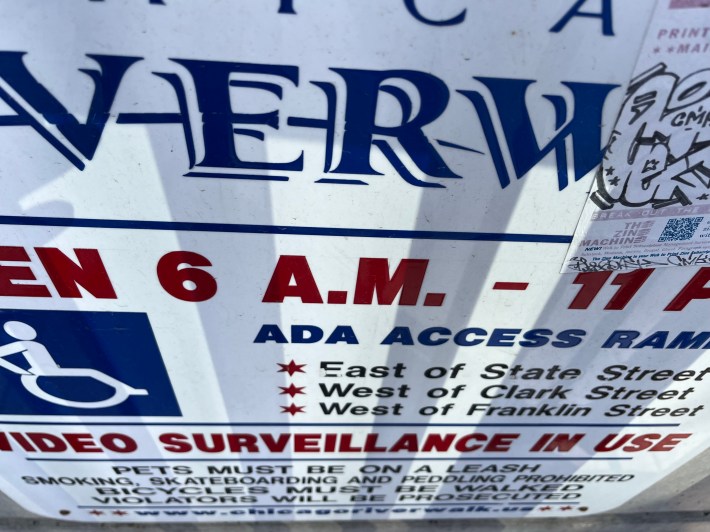
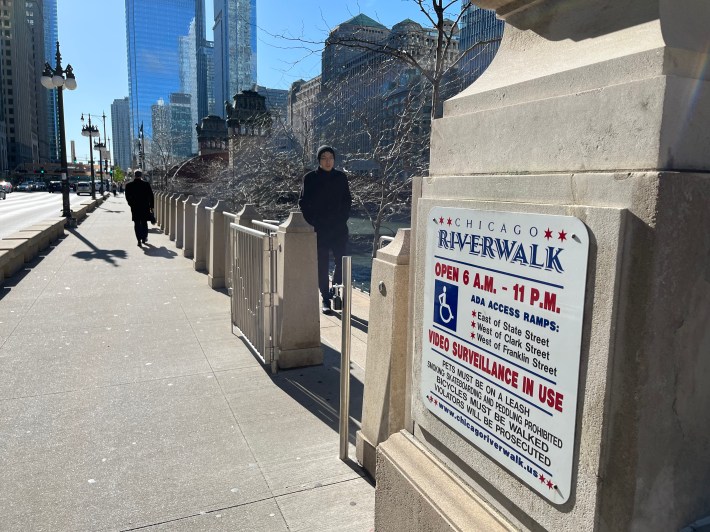
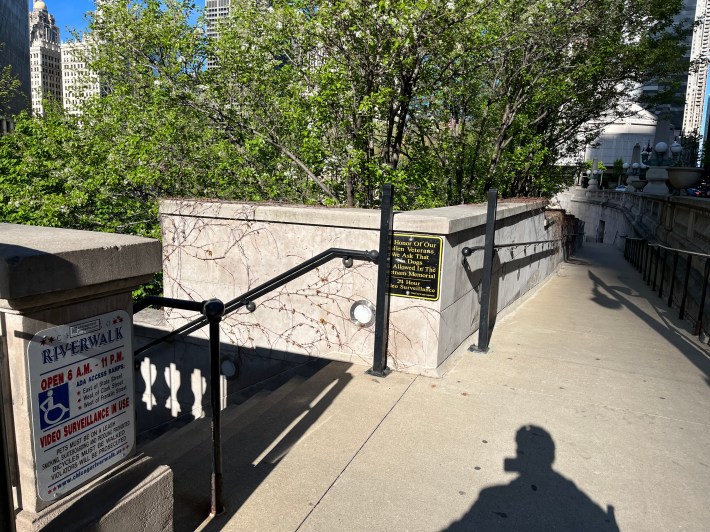
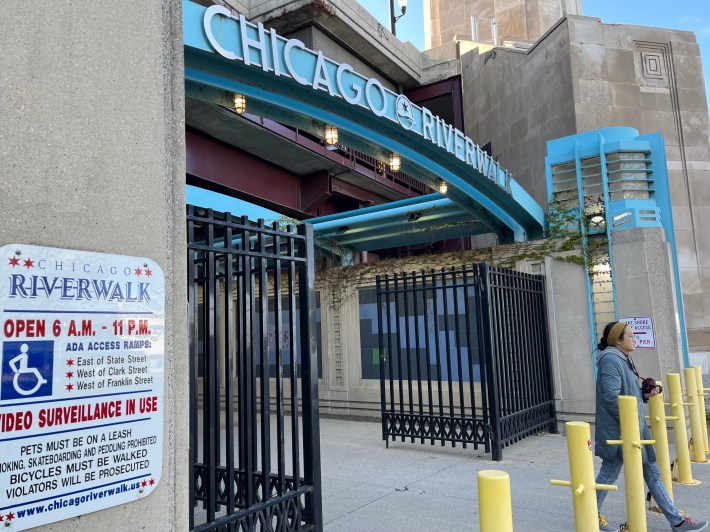
Therefore the "designated locations where bikes must be walked" as indicated by "posted signage pertaining to your bicycle," which F2M referred to in its FAQ answer, actually means the entire riverwalk!
I wrote to F2M and CDOT pointing out this issue, and asked if there are actually any stretches of the riverwalk where cycling is allowed. And if so, I asked, are there any plans to update the signage to make it clear when and where bike riding isn't and is permitted? If either department replies in the future, I'll post an update to this article.
Again, at this point I'm not trying to razz anyone. I'd just like to see a win-win solution worked out that would satisfy Ald. Reilly, the majority of his constituents, the riverwalk vendors, and bike riders. After all, the latter were promised a new car-free cycling route when the riverwalk was first pitched.
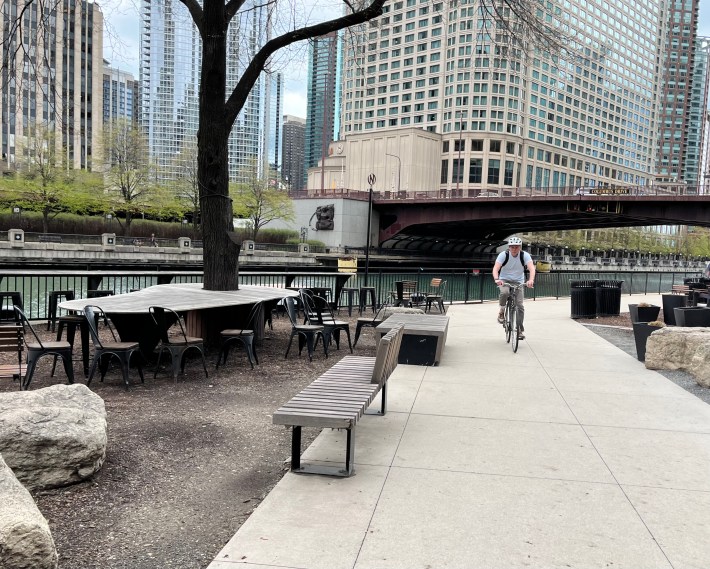
One easy short-term solution would be to post signs stating that it's legal to ride on the riverwalk from the Lakefront to the State Street ramp. Ideally a one-block stretch of 2-way protected bike lane would be added on the north side of Wacker to connect to the two-way Dearborn north-south protected bike lane. And the CDOT bike map should be updated to reflect those changes.
In the long run, all concerned parties, including Reilly, have voiced support for swapping a lane or two of mixed-traffic lanes on Wacker Drive for longer-distance protected bike lanes. That would further relieve crowding on the riverwalk.
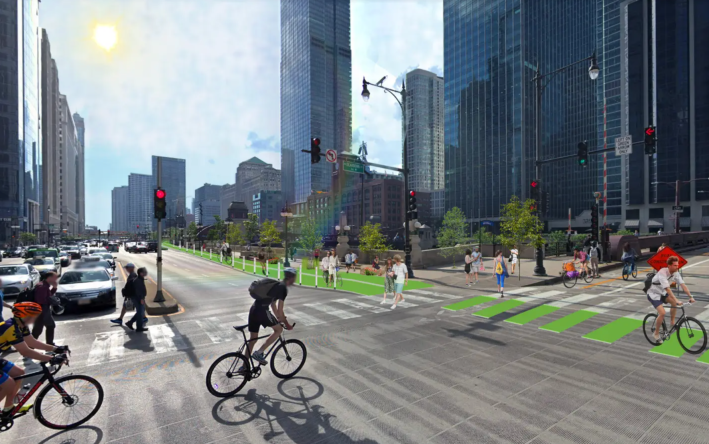
"We haven't heard any updates about a permanent PBL on Wacker from CDOT," Active Transportation Alliance advocacy manager Alex Perez told me last week. "Unfortunately, once the [Dearborn bridge reconstruction] project was completed, the PBL infrastructure on Wacker was removed. When Wacker had a PBL, we saw there was minimal impact to the traffic flow."
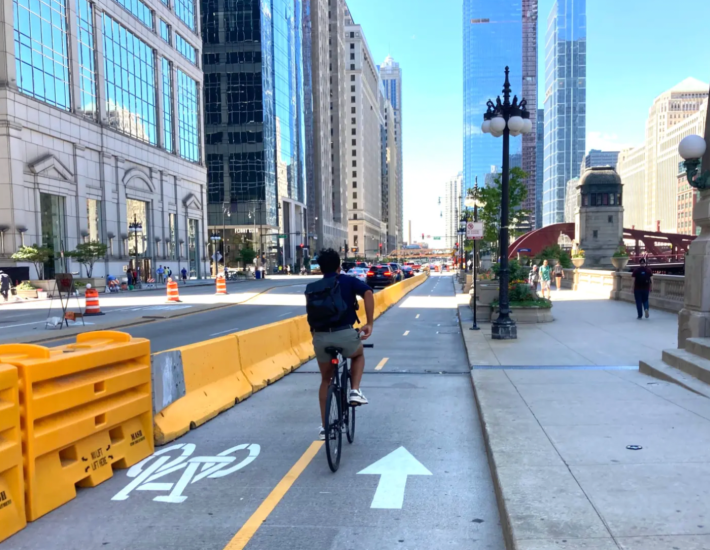
"Adding a permanent PBL on Wacker would create a safer alternative than riding on the riverwalk and help people safely connect to the new PBL extension on Dearborn [north of Kinzie Street]," Perez noted.
So let's change the signage on the riverwalk to make it clear that bicycling is allowed on at least some parts of the path. And/or, in the not-too-distant future, let's make a long-distance, permanent Wacker Driver protected bike lane a reality. Your move, F2M, CDOT, and Ald. Reilly.
